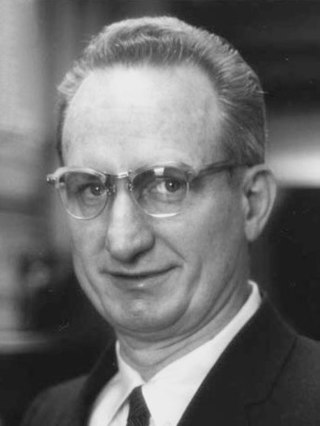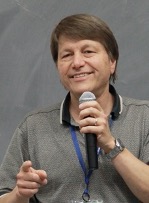Related Research Articles
Superfluid helium-4 is the superfluid form of helium-4, an isotope of the element helium. A superfluid is a state of matter in which matter behaves like a fluid with zero viscosity. The substance, which looks like a normal liquid, flows without friction past any surface, which allows it to continue to circulate over obstructions and through pores in containers which hold it, subject only to its own inertia.
A tachyon or tachyonic particle is a hypothetical particle that always travels faster than light. Physicists believe that faster-than-light particles cannot exist because they are not consistent with the known laws of physics. If such particles did exist they could be used to send signals faster than light. According to the theory of relativity this would violate causality, leading to logical paradoxes such as the grandfather paradox. Tachyons would exhibit the unusual property of increasing in speed as their energy decreases, and would require infinite energy to slow down to the speed of light. No verifiable experimental evidence for the existence of such particles has been found.

Leo James Rainwater was an American physicist who shared the Nobel Prize in Physics in 1975 for his part in determining the asymmetrical shapes of certain atomic nuclei.

Diffusion-limited aggregation (DLA) is the process whereby particles undergoing a random walk due to Brownian motion cluster together to form aggregates of such particles. This theory, proposed by T.A. Witten Jr. and L.M. Sander in 1981, is applicable to aggregation in any system where diffusion is the primary means of transport in the system. DLA can be observed in many systems such as electrodeposition, Hele-Shaw flow, mineral deposits, and dielectric breakdown.

A colloidal crystal is an ordered array of colloidal particles and fine grained materials analogous to a standard crystal whose repeating subunits are atoms or molecules. A natural example of this phenomenon can be found in the gem opal, where spheres of silica assume a close-packed locally periodic structure under moderate compression. Bulk properties of a colloidal crystal depend on composition, particle size, packing arrangement, and degree of regularity. Applications include photonics, materials processing, and the study of self-assembly and phase transitions.
Pierre C. Hohenberg was a French-American theoretical physicist, who worked primarily on statistical mechanics. Hohenberg studied at Harvard, where he earned his bachelor's degree in 1956 and a master's degree in 1958, and his doctorate in 1962. From 1962 to 1963, he was at the Institute for Physical Problems in Moscow, followed by a stay at the École Normale Supérieure in Paris. From 1964 to 1995 he was at Bell Laboratories in Murray Hill. From 1985 to 1989, he was director of the department of theoretical physics and from 1989 to 1995 was "Distinguished Member of Technical Staff". From 1974 to 1977, he was also professor of theoretical physics at the TU München, where he had previously been a 1972–1973 guest professor. From 1995 to 2003 he was "Deputy Provost of Science and Technology" at Yale University. Subsequently, he was the Yale "Eugene Higgins Adjunct Professor of Physics and Applied Physics". Hohenberg was additionally from 1963 to 1964 and again in 1988 guest professor in Paris and in 1990–1991 a Lorentz-Professor in Leiden. In 2004 he became Senior Vice Provost of Research at New York University, a position held until 2011, when he stepped down to join the Physics Department as Professor. In 2012 he became Emeritus Professor of Physics at NYU.
John Bryan Taylor is a British physicist known for his contributions to plasma physics and their application in the field of fusion energy. Notable among these is the development of the "Taylor state", describing a minimum-energy configuration that conserves magnetic helicity. Another development was his work on the ballooning transformation, which describes the motion of plasma in toroidal (donut) configurations, which are used in the fusion field. Taylor has also made contributions to the theory of the Earth's Dynamo, including the Taylor constraint.

Robert William Boyd is an American physicist noted for his work in optical physics and especially in nonlinear optics. He is currently the Canada Excellence Research Chair Laureate in Quantum Nonlinear Optics based at the University of Ottawa, Professor of Physics cross-appointed to the School of Electrical Engineering and Computer Science at the University of Ottawa, and Professor of Optics and Professor of Physics at the University of Rochester.

Modern searches for Lorentz violation are scientific studies that look for deviations from Lorentz invariance or symmetry, a set of fundamental frameworks that underpin modern science and fundamental physics in particular. These studies try to determine whether violations or exceptions might exist for well-known physical laws such as special relativity and CPT symmetry, as predicted by some variations of quantum gravity, string theory, and some alternatives to general relativity.
Gary T. Horowitz is an American theoretical physicist who works on string theory and quantum gravity.
Raymond Ethan Goldstein FRS FInstP is Schlumberger Professor of Complex Physical Systems in the Department of Applied Mathematics and Theoretical Physics (DAMTP) at the University of Cambridge and a Fellow of Churchill College, Cambridge.
Elihu Abrahams was a theoretical physicist, specializing in condensed matter physics.
Viswanathan Kumaran is an Indian chemical engineer, rheologist and a professor at the Department of Chemical Engineering of the Indian Institute of Science. He is known for his studies on stability of flow past flexible surfaces and is an elected fellow of the Indian Academy of Sciences, Indian National Science Academy and the Indian National Academy of Engineering. The Council of Scientific and Industrial Research, the apex agency of the Government of India for scientific research, awarded him the Shanti Swarup Bhatnagar Prize for Science and Technology, one of the highest Indian science awards for his contributions to Engineering Sciences in 2000. A recipient of the TWAS Prize in 2014 and the Infosys Prize 2016 in the Engineering and Computer Science category, Kumaran was listed in the Asian Scientist 100, a list of top 100 scientists from Asia, by the Asian Scientist magazine.
Richard Anthony Lewis Jones is professor of Materials Physics and Innovation Policy at the University of Manchester having been professor of physics at the University of Sheffield until 2020.

Amalie L. Frischknecht is an American theoretical polymer physicist at Sandia National Laboratories in Albuquerque, New Mexico. She was elected a fellow of the American Physical Society (APS) in 2012 for "her outstanding contributions to the theory of ionomers and nanocomposites including the development and application of density functional theory to polymers". Her research focuses on understanding the structure, phase behavior, and self-assembly of polymer systems, such as complex fluids polymer nanocomposites, lipid bilayer assemblies, and ionomers.

Mark Owen Robbins was an American condensed matter physicist who specialized in computational studies of friction, fracture and adhesion, with a particular focus on nanotribology, contact mechanics, and polymers. He was a professor in the department of physics and astronomy at Johns Hopkins University at the time of his death.
Dietrich Belitz is an American theoretical physicist on the faculty of the University of Oregon. He studies statistical mechanics and condensed matter physics.
Blayne Ryan Heckel is an American experimental physicist, known for his research involving precision measurements in atomic physics and gravitational physics. He is now a professor emeritus at the University of Washington in Seattle.
Robert Everett Ecke is an American experimental physicist who is a Laboratory Fellow and Director Emeritus of the Center for Nonlinear Studies (CNLS) at Los Alamos National Laboratory and Affiliate Professor of Physics at the University of Washington. His research has included chaotic nonlinear dynamics, pattern formation, rotating Rayleigh-Bénard convection, two-dimensional turbulence, granular materials, and stratified flows. He is a Fellow of the American Physical Society (APS) and of the American Association for the Advancement of Science (AAAS), was Chair of the APS Topical Group on Statistical and Nonlinear Physics, served in numerous roles in the APS Division of Fluid Dynamics, and was the Secretary of the Physics Section of the AAAS.
References
- ↑ T. A. Witten, Jr. & L. M. Sander (1981). "Diffusion-Limited Aggregation, a Kinetic Critical Phenomenon". Physical Review Letters. 47 (19): 1400–1403. doi:10.1103/PhysRevLett.47.1400.
- ↑ Thomas A. Witten (2007). "Stress focusing in elastic sheets". Reviews of Modern Physics. 79 (2): 643–675. doi:10.1103/RevModPhys.79.643.
- ↑ "University of Chicago News". news.uchicago.edu.
- ↑ Robert D. Deegan; Olgica Bakajin; Todd F. Dupont; Greg Huber; Sidney R. Nagel; Thomas A. Witten (1997). "Capillary flow as the cause of ring stains from dried liquid drops". Nature. 389 (6653): 827–829. doi:10.1038/39827. S2CID 205027233.
- ↑ "University of Chicago News Profile".
- ↑ "Prize Recipient". www.aps.org.
- ↑ "Lorentz Chair since 1955". www.lorentz.leidenuniv.nl.